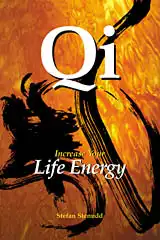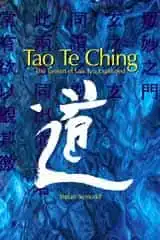|
Tao Te Ching
THE TAOISM OF LAO TZU
|
Tao Te Ching
|
The Book
The Taoism of Lao Tzu Explained. The great Taoist philosophy classic by Lao Tzu translated, and each of the 81 chapters extensively commented. Click the image to see the book at Amazon (paid link). |
The Clarity of Obscurity
This is an outburst of the poet in Lao Tzu. Here and in many other chapters of the book, he suddenly marvels at the magnificent mystery of it all. But it's not a mystery in which he is lost or blinded. Quite the opposite.
Because he dares to face the mystery in all its obscurity, it becomes clear to him.
He doesn't mind the darkness, since he is quite aware of what it hides. The evasiveness doesn't make him doubt, since he has already understood. Instead, he sees this evasiveness and darkness as evidence of the profundity. Anything less profound would be easier to perceive and to comprehend.
Tao, the Way, is primordial. Not only was it present at the very birth of the world, but it was the actual origin out of which the world emerged. Its own origin, if there is one, is the most distant of all.
So, Tao must be obscure, evasive, and vague. Anything by which to describe Tao is of later date and lesser significance, so Tao remains forever impenetrable. Its nature may be grasped intuitively, but not explained.
That's the elusive character of many truly profound things in life, in art, and in science. What we easily express in a few sentences is unlikely to penetrate the surface. Once we really dig deep into what we examine, the truth becomes more and more absurd, and less possible to convey to those who remain on the surface.
During the 20th century, natural science revealed a lot of such absurdities, and found them to be core components of the whole universe.
Astronomy has taught us that the cosmos is not eternal in its width, but still impossible to exit, and its vastness was born out of a single point, a center with minimal volume but unfathomable density.
Einstein proved that time is not a constant. Much to his frustration, quantum physics discovered that the smallest pieces of matter refuse inspection, since they are affected by our scrutiny.
Not to mention string theory, yet to be accepted, where the building blocks of the universe seem to be dancing.
The universe appears to be described quite accurately, although obscurely, by the words of Lao Tzu.
The Center of Tao
Lao Tzu speaks repeatedly about the center of Tao, as if it would differ from its periphery or anything in between. But Tao is the very law of nature, so it contains no differences or discrepancies. Otherwise there would be anomalies and exceptions in the way the universe works. It would collapse, as would Tao.What Lao Tzu refers to is the difference between the outside view, when Tao is observed by those who don't comprehend it, and what its true nature really is.
The latter can be called its center. The actual word used also means middle, as in the Chinese name of the country: the Middle Kingdom. That name stems from an old belief _ or aspiration – of being the country in the middle of the world, as if China were its very axis.
Lao Tzu expresses no such belief about the country he served before leaving to write his book, but when he points to the origin of all, he has to go to the middle. Neither in his understanding of the world, nor in modern astronomical theory, is it possible for a universe to appear from anywhere else than its middle, its center. Nothing can appear from its own periphery.
So, when Lao Tzu speaks of the center of Tao, he speaks of that which was the origin of the whole world.
In that way, Tao has form because of all the forms being born out of it, and it has substance through all the matter that came out of it, filling the world. It also has essence, which is its creative force, its active presence. Without that essence, no world would have emerged. Tao would only have been an eternal possibility, resting in its own perfection.
The essence of Tao is similar to the expressed will of the Bible's God, uttering: "Let there be..." Tao may have no similarly traceable intention, but the result is the same. The universe was born, because that event was in the nature of Tao.
By What?
The chapter ends with a mysterious remark: "By this." Surely, this is Lao Tzu's humor at play. How else to end a chapter about the mysterious nature of Tao?The word Tao was known long before the days of Lao Tzu, and this he was certainly aware of. So were his expected readers. Tao and its complex meaning can be seen in texts and traditions dating so far back from the days of Lao Tzu that he would probably have had no idea of their origin in time. So, on that very concrete level, he uses the well-known antiquity of the word Tao as an argument for why it must describe the very origin of all.
Tao was known in cosmological speculations of Lao Tzu's time, and the time before his. T'ien chih Tao, Heaven's Way, was used in descriptions of the divine and other things beyond human understanding. Lao Tzu would not have caused any uproar in the Chinese minds of his time, when stating that the great antiquity of the word Tao was evidence of its cosmic significance.
But his comment has several levels. He is also likely to refer to the elusive obscurity of Tao. Something as vague and incomprehensible must be of fundamental importance and dignity. What man cannot comprehend is of divine nature. If it were easier to grasp, it would not be as elevated. In that way, the mystery of Tao is a sign of its greatness.
In all cultures of old, what was not understood was regarded as divine or Heavenly, belonging to a greater realm than that of human existence. The many wonders in nature were seen as indications of a great order of things, governed elsewhere by other forces than those that humans and animals had at their disposal. Whether those forces were in the hands of gods of some sort or not, they were definitely out of human reach.
Not only were humans unable to copy those feats, but also to understand them. Ancient man made little difference between the two. These inabilities were the two sides of the same coin. What could not be understood could not be done, and what could not be done could not be understood.
In a way, this is still true, although we have all kinds of explanations – but not to the very core, the center of the workings of the universe. Some natural laws we can utilize to our advantage, and some processes in nature we can copy for our own benefit. But we lack certainty as to what really makes everything work, at the very bottom – what Lao Tzu calls the center. Our sciences are sketch works, where closer inspection shows that many details are still missing. Our lines have not connected all the dots.
Mostly, we lack the knowledge that makes sense to it all. The unified field theory that Einstein dreamed about is still outside our grasp. So is the exact state the universe was in, before its Big Bang. Like Lao Tzu, when we look at the beginning we see the mystery. It can be named, but not explained.
We know that it has to be there, since we can observe its surroundings, to which we do ourselves belong. But we have yet to reach it.
NEXT
Tao Te Ching Explained
Preface
Introduction
Literature
translated and explained by Stefan Stenudd.
1 |
2 |
3 |
4 |
5 |
6 |
7 |
8 |
9 |
10 |
11 |
12 |
13 |
14 |
15 |
16 |
17 |
18 |
19 |
20 |
21 |
22 |
23 |
24 |
25 |
26 |
27 |
28 |
29 |
30 |
31 |
32 |
33 |
34 |
35 |
36 |
37 |
38 |
39 |
40 |
41 |
42 |
43 |
44 |
45 |
46 |
47 |
48 |
49 |
50 |
51 |
52 |
53 |
54 |
55 |
56 |
57 |
58 |
59 |
60 |
61 |
62 |
63 |
64 |
65 |
66 |
67 |
68 |
69 |
70 |
71 |
72 |
73 |
74 |
75 |
76 |
77 |
78 |
79 |
80 |
81 |
Tao Te Ching Explained
James Legge's Tao Te Ching
Aleister Crowley's Tao Te Ching
The 1st Chapter of Tao Te Ching in 76 Versions
Lao Tzu — Legendary Author of Tao Te Ching
My Taoism BooksClick the image to see the book at Amazon (paid link).
The Taoism of Lao Tzu Explained. The great Taoist philosophy classic by Lao Tzu translated, and each of the 81 chapters extensively commented. |
About Cookies
My Other Websites:
I Ching Online
The 64 hexagrams of the Chinese classic I Ching and what they mean in divination. Try it online for free.
Qi Energy Exercises
The ancient Chinese life energy qi (chi) explained, with simple instructions on how to exercise it.
Life Energy
The many ancient and modern life force beliefs all over the world explained and compared.
Taoismen på svenska
Other Books by Stefan Stenudd
Click the image to see the book at Amazon (paid link).
 Cosmos of the Ancients
Cosmos of the Ancients
The Greek philosophers and what they thought about cosmology, myth, and the gods.
 Qi — Increase Your Life Energy
Qi — Increase Your Life Energy
The life energy qi (also chi or ki) explained, with exercises on how to awaken, increase and use it.
 Aikido Principles
Aikido Principles
Basic concepts of the peaceful martial art. Aikido principles, philosophy, and fundamental ideas.
 Life Energy Encyclopedia
Life Energy Encyclopedia
Qi, prana, spirit, ruach, pneuma, and many other life forces around the world explained and compared.
 Archetypes of Mythology
Archetypes of Mythology
Jungian theories on myth and religion examined, from Carl G. Jung to Jordan B. Peterson.
 Stefan Stenudd
Stefan Stenudd
About me
I'm a Swedish author and aikido instructor. In addition to fiction, I've written books about Taoism and other East Asian traditions. I'm also an historian of ideas, researching ancient thought and mythology. Click the image to get to my personal website.Contact

 Tao Te Ching
Tao Te Ching Tao Quotes
Tao Quotes Fake Lao Tzu Quotes
Fake Lao Tzu Quotes